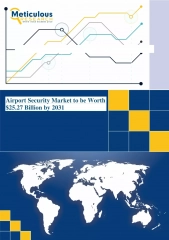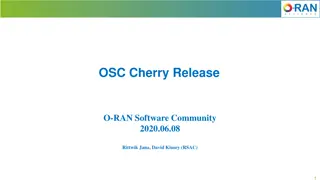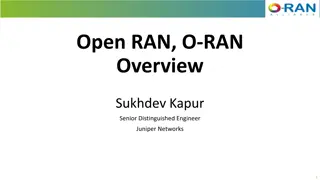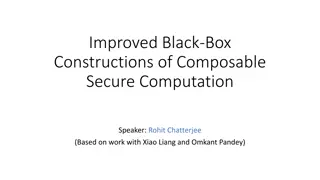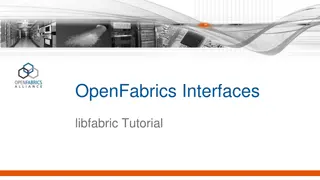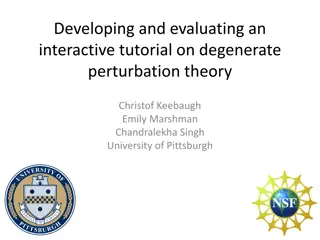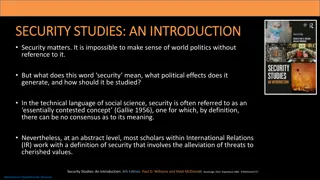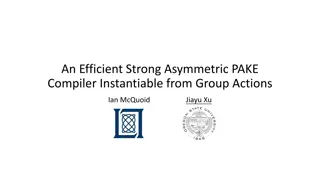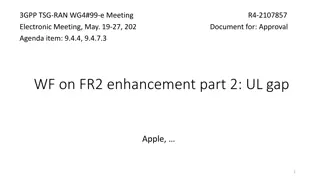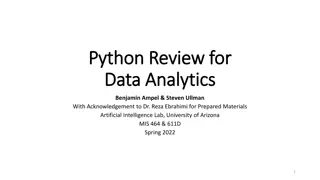Understanding Universally Composable Security: A Tutorial by Ran Canetti
This tutorial by Ran Canetti explores the concept of Universally Composable Security (UC) framework, aiming to elucidate its rationale and extend composability analysis beyond cryptography. The event covers topics like background, detailed framework workings, capturing attacks, introducing projects, and group work. It emphasizes the importance of security analysis that faithfully represents realistic attacks, specifies security concerns precisely, and remains technically manageable with meaningful guarantees. The tutorial advocates for a general model for security analysis for a better understanding of security and simplification of analytical work, despite potential complexity challenges.
Download Presentation

Please find below an Image/Link to download the presentation.
The content on the website is provided AS IS for your information and personal use only. It may not be sold, licensed, or shared on other websites without obtaining consent from the author. Download presentation by click this link. If you encounter any issues during the download, it is possible that the publisher has removed the file from their server.
E N D
Presentation Transcript
Universally Composable Security: A Tutorial Ran Canetti BU, March 18-19 2016
Intro Goal of the event: Explain the rationale and workings of the UC framework to non-cryptographers Alterior motive: Extend composable analysis beyond crypto People s backgrounds Plan for the event Website for products? Practicalities: Food, facilities
Lecture plan Session 1: Background The UC framework general idea Session 2: Details of the framework Session 3: Capturing attacks and concerns: examples Session 4: Introduction of projects Session 5: Work in groups
What do we want from security analysis? Should faithfully represent realistic attacks Should specify the security concerns and properties in a meaningful and precise way Should capture all realistic attacks in the expected execution environment. Should not be over-restrictive. Guarantees should remain meaningful in many (any?) environment Should be technically manageable Should be modular: Simplify the analytic process Provide more meaningful security
Advocating a general model for security analysis Pro: Provides better understanding of security Better expressibility, analysis is more meaningful Enables modularity and composability Overall simplification of the analytical work Con: Model can be complex Hard to get it right
Frameworks for modeling distributed systems CSP [Hoare] pi-calculus [Milner] spi-calculus [Abadi-Gordon] I/O automata [Lynch] Pros: Much analytical work, verified, support modularity, some automated analysis Cons: Not easy to model computational concerns Modeling a bit restrictive (scheduling, addressing)
Traditional cryptographic modeling Semantic security Zero Knowledge Commitment Secure function evaluation Pro: Captures cryptographic security (against computationally bounded attacks) relatively simple Con: Not modular, security guarantees not always meaningful in a larger context.
Want: - The best of both - Be able to play on the tradeoff: Simple/Abstract Concrete/complex
Step 1: model computer systems and attacks Model should: Allow capturing: Realistic systems (processors, cores, ram, disks, networks, processes, os, applications, delays, time randomness ) Realistic attacks: network, exploits, side channels, Human Information seen by different components efficiency, resource bounds Allow different levels of abstraction/detail Be simple, natural, intuitive Very tricky the root of many deficiencies
Step 2: Capture security properties For instance: Trace properties ( correctness ): In each execution, if event C happens then event E happens Probabilistic statements Secrecy /privacy Liveness Timing of events Costs and quantitative tradeoffs Combinations of the above Eg attack can either learn or modify, but not both attack can learn/modify, but only after a certain event success of attack is proportional to the amount of resources expended
Step 3: Prove that a system satisfies a given set of properties Questions By hand? Automated? How tractable? Based on what assumptions? Model assumptions Computational hardness assumptions Proof re-use: Modularity? Robustness?
The UC approach: Specification via an Ideal-Service The idea: The security of a system is reflected only in its effects on the rest of the external environment. Therefore to capture the desired security of system P: Write an ideal system F that captures the desired effect System P is secure for F if it looks the same as F to any external environment. Note: F need not be efficient or even realistically implemented. All we care about is its responses to the environment.
Specification via an Ideal-Service Pro: Expressive: Can naturally express any combination of properties Amenable to modular analysis Con: Detailed, sometimes a bit roundabout
Specification via an Ideal-Service: Zoom in First attempt: P realizes F if for all environment E, E||P ~ E||F (reminiscent of observational equivalenve [Milner]) Correspondence is too tight.. So too restricted (eg, ~ is an equivalence relation) How to relax?
Specification via an Ideal-Service: Adding simulation Idea: Split the interaction of the system P with the external world: Application Interface : the inputs from the users of P and the outputs to the users of P . (This is the functionality of P). All the rest: consumed resources , communication, internal leakage of information, etc. Allow fudging E s view of the non-API interaction: Def: P realizes F if there exists S such that for all E, E||S||F ~ E||P
Recap: Simulation-based security specification ~ E E API API F P effects Side- effects Side- effects Side- S System P realizes specification F if there exists S such that for all E, ExecE,P ~ ExecE,S,F (ExecE, returns the output of E from the execution )
Specification via an Ideal-Service: Adding simulation Def: P realizes F if there exists S such that for all E, ExecE,P ~ ExecE,S,F Rationale for adding S: Any manipulation that P can do to E, could have done also by F (by adding S to E). Furthermore this can be done without modifying the API of F. Or: Any manipulation that E can do to P, could have done also to F (by using S). Furthermore this can be done without modifying the API of F. Definition is no longer symmetric
Compare with cryptographic-style simulation: Semantic Security of Encryption Semantic security of encryption: Want to capture Enc(m) gives no knowledge on m Game-based: An encryption algorithm Enc is sem. Secure if no (feasible) A wins w.p. >1/2+negl in game: A m1,m2 A Enc(mb) b {1,2} A b , wins if b =b Simulation-based: For any A there is a simulator S such that for all m, Enc(m) ~ S(|m|) Thm: Enc is Sim-Sem-Sec iff it is Game-Sem-Sec.
Cryptographic-style simulation: Zero-Knowledge & WI [P,V] is an interactive protocol where P,V have joint input x, P has secret input w, (and V wants to learn whether R(x,w) for some relation R) Want to capture Interaction with P does not give V any knowledge on w [P,V] is zero knowledge if for all V* there is a simulator S such that for all V*,x,w, [P(x,w),V*(x)] ~ S(x) [P,V] is witness indistinguishable (WI) if for all V*, x,w1,w2 [P(x,w1),V*(x)] ~ [P(x,w2),V(x)] Thm: ZK WI, but not vice versa!
Differences from traditional cryptographic simulation Captures both secrecy and correctness guarantees Focus on the effect on the environment, rather than on protocol Require a single simulator (as opposed to a simulator per adversary) Partial credits to this definitional style: [Goldreich Micali Wigderson87,Goldwasser Levin 90,Micali Rogaway 91, Beaver 91, Canetti 92-95-00- 01,Pfitzmann-Waidner 93-98-00 ]
Recap: Simulation-based security specification ~ E E API API F P effects Side- effects Side- effects Side- S System P realizes specification F if there exists S such that for all E, ExecE,P ~ ExecE,S,F
Example: Authenticated message transmission Fauth: On input (Send,m, B ) from A , output (Sent,m, A ) to B . F has no side-effects, S needs to generate side-effects on its own, without knowing anything Need to relax:
Example: Authenticated message transmission Fauth: On input (Send,m, B ) from A , leak (A,B,m) to S When S returns ok , output (Sent,m, A ) to R . S learns A,B,m, and *can delay delivery* (Analysis of MAC-based protocol on board)
Example: Secure message transmission Fsmt: On input (Send,m, B ) from A , leak (A,B,|m|) to S When S returns ok , output (Sent,m, A ) to B . S learns A,B,|m|, and *can delay delivery* (Analysis of Enc-based protocol on board) How to model leaky/imperfect encryption?
Example: Zero Knowledge proofs Fzk(R): On input (Prove,x,w,B) from A, leak (A,B,x,R(x,w)) to S When S returns ok , output (Verified,A,x,R(x,w)) to B. B learns whether R(x,w) S,B learn only R(x,w), w remains secret.
Example: Key Exchange Fke: On input (KE,B) from A, choose a key k and leak (A,B) to S. On input (KE,B) from A, leak (A,B) to S. When S returns (ok,P) for P={A,B}, output (A,B,k) to P. A,B obtain a fresh joint key S learns that A,B share a key.
Example: File System with Integrity Ffsi: On input (Init,fname,UID) record (fname,UID) On input (W,fname,update-contents,UID ): If UID =UID then update the fname with update-contents, else return an error code. On input (read,fname,UID) leak fname to S. When S says ok, return the contents of fname to UID. Write-control Integrity is guaranteed, no confidentiality guarantees.
Composition of protocols and systems What happens to our security guarantees when the analyzed system runs alongside others? How do the systems interact? Intentionally? Adversarially? Do the systems have joint inputs? State? Modules? Do they run in parallel? concurrently? Does one system use the other? Are the systems coordinated? Same system?
What Can Go wrong? Protocols reuse state (eg, keying material) Security guarantees break due to bad interaction (ZK ) Security guarantees become inadequate (NM-Com) Security APIs don t hold up
Example: The Needham-Schroeder key exchange protocol B A (knows B s public encryption key EB) (knows A s public encryption key EA) Choose a random k-bit NA ENCEB(NA,A, B) If decryption and identity Checks are ok then Choose a random k-bit NB and send ENCEA(NA, NB,A, B) If identity and nonce checks are ok then output NB and send ENCEB(NB) If nonce check is ok then Output NB
The protocol satisfies the requirements: Key agreement: If A, B locally output a key with each other, then this key must be NB.(Follows from the untamperability of the encryption.) Key secrecy: The adversary only sees encryptions of the key, thus the key remains secret. (Follows from the secrecy of the encryption.) Indeed, the protocol complies with early notions of security (e.g. [Dolev-Yao83, Bellare-Rogaway93, Datta-Derek-Mitchell-Warinschi06]).
Using the key for encrypting messages Assume that the protocol is composed with an encryption protocol that uses the generated key to encrypt messages. Furthermore: -The encryption protocol is one-time-pad -The message is either buy or sell : B A ENCEB(NA,A, B) ENCEA(NA, NB,A, B) ENCEB(NB) NB+M
An attack against the composed protocol: E B A ENCEB(NA,A, B) ENCEA(NA, NB,A, B) ENCEB(NB) E can check whether C=NB+ sell , or C=NB+ buy : Let C'=C+ sell . C=NB+M ENCEB(C') Note: If M= sell then C'=(NB+ sell )+ sell =NB. Else C' != NB. Thus, B accepts the exchange if and only if M= sell .
The problem: The adversary uses B as an oracle for whether it has the right key. But the weakness comes to play only in conjunction with another protocol (which gives the adversary two possible candidates for the key...) Consequently, need to explicitly incorporate the encryption protocol in the analysis of the key exchange protocol...
Want: A way to argue about the propagation of security in such situations The methodology: Security preserving composition. Will see: A (single) composition operation on systems Can express most other composition methods Preserves security
The composition operation: Universal Composition Ingredients: Protocol (system) that realizes ideal service Protocol (System) that makes API calls to Result: A protocol Where: the calls to are replaced by calls to Values returned from are treated as coming from Note: (number of parties components, communication etc) Just like subroutine substitution in sequential algorithms, except that each protocol/system may have many participants. (Still, calls are made locally by each participant.) There may be multiple instances of and . and have similar API but very different non-API behavior
The universal composition operation E E API API effects Side- effects Side- Note: each protocol can consist on many smaller components and parties.
The universal composition theorem E E ~ API API effects Side- effects Side- effects Side- S E E API API ~ effects Side- effects Side- I
The composition theorem: If protocol realizes ideal service and protocol realizes Ideal Service , then protocol realizes . More generally, protocol is just as secure as protocol . Corollaries: Allows for modular security analysis Allows arguing about security in arbitrary environments Gives concurrency for free
The actual framework The system model: Computing elements, scheduling, addressing, time bounds Model of protocol execution Protocol emulation, ideal services The composition operation and theorem
The basic computing unit: An interactive machine (IM) An abstract computing device Can model a node (cpu+RAM), a cluster of nodes, a process, an enclave, Formally, an IM is a TM* with: some special tapes (ports): Identity tape (with code + id string, id=(pid,sid)) Input tape Incoming communication tape Incoming subroutine output tape Outgoing message tape An external write instruction (tbd) * Can also think of an IM as a program in some higher language, e.g. Python or Java, with the appropriate data structures.
A system of IMs A system is a pair (I,C) where I is an IM C is a control function C:{0,1}* {allow,disallow} An instance of an IM M is a pair =(M,id) where id is the contents of the identity tape A configuration of is the entire contents of tape and control An execution is a sequence of configurations: In each config a single machien is active, initially I Initial config is the initial config of I The active machine runs till it performs external write. Then, the activation is suspended, the message on outgoing tape is delivered and the recipient machine is activated. The execution ends when I halts. The output is output of I.
Message delivery and order of activations The information on the outgoing message tape consists of: - ID of sending machine =(M ,id ) - ID of target machine Tape name (input, incoming message, subroutine output) r {0,1} reveal bit m message Effect: If C(currrent execution prefix)=disallow then message is not delivered and I is activated. Else: If no MI with identity id exists in the execution prefix then one is created and initialized with code M . (unless M =@, in which case I gets activated) If M =@ or M is the code of the MI with id then the message is written to the appropriate tape of that MI Else (Mi with id exists but with code different than M ) then transitions to an error state and I is activated next.
Notes Number of MI s is unbounded Allows dynamic code generation ID of each MI is unique in the system Need to know ID of an MI in order to send to it Mis know their IDs Scheduling is sequential and unfair
More definitions Extended systems: C(exec prefix) = new ID and code for source and target is a subroutineof if wrote to the subroutine output tape for or wrote to the input tape of . A protocol is an interactive machine. An instance of protocol P in an execution prefix is a set of MI s with program P and the same SID
Polynomial time A machine M is polynomial time if its runtime is bounded by a polynomial in N, where N = # bits written on M s input tap # bits that M wrote on input tapes of other machines. Can see: If all machines in a system of ITMS are polynomial (and are all bounded by the same polynomial) then the system halts within polynomial time. Parameterized systems: All machines get inputs of at least some polynomial length.
The model of protocol execution The idea: Keep it simple. Run a single instance of the protocol, with an environment and an adversary. Participants: Environment E, adversary A, parties of protocol . E starts, invokes A, gives inputs to parties of a single instance of , obtains outputs from parties of . Parties of generate subroutines, outputs, and send messages to each other *via the adversary*. Adversary obtains messages from parties, and either delivers some (arbitrarily modified) incoming messages to parties, or generates output for E. (Rules are enforced by the control function.)
The model of protocol execution Note: The model is very rudimentary: Parties communicate only via the adversary No party corruption operations Done for sake of simplicity and generality. Will add later. (Note: Control F erases ID of E is from inputs to parties, and erases code of parties from outputs to E)
Protocol emulation ~ E E API API effects Side- A effects Side- effects Side- S Protocol UC-emulates protocol if for all A there exists S such that for all E*, ExecE,A, ~ ExecE,S, . (ExecE, returns the output of E from the execution ) * Quantify only over balanced environments



